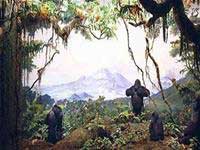Scientists from the Union of Vietnamese Science and Technology Associations are urgently finalizing a project to lay the foundation for the first natural history museum in Vietnam.
 |
|
The natural history museum will not only preserve rare gene resources and help regulate the climate for one of the world’s highest-density urban areas, but it will also be a major attraction for tourists from all directions. |
It is promising that “The Ho Chi Minh City government has pledged to allocate at least 7-8 million USD to construct this 30-hectare natural history museum,” said Professor and Doctor Vu Tuyen Hoang, President of the Union of Vietnamese Science and Technology Associations (VUSTA), during a meeting with leading experts in biology and botany in Vietnam held in Hanoi on February 13.
The story began two years ago when Engineer Le Dung, working at the Union of Public Technology and Production Science (PTC) under VUSTA, was informed by foreign colleagues during an overseas trip. Upon returning home, he reported the idea and received immediate approval from the leadership.
Professor Vu Tuyen Hoang himself and the globally renowned environmental expert, Professor Vo Quy, President of the Ecological Society, traveled to various locations to promote the project.
In the most dynamic city in the country, Ho Chi Minh City, their efforts were not in vain. Decisions progressed at lightning speed compared to other regions and even to a few years ago. A site of about 30 hectares in District 9 was immediately approved to bring the idea to life.
Additionally, the leadership of Ho Chi Minh City promised to invest no less than 7-8 million USD, equivalent to 112-128 billion VND, for this artificial nature conservation project.
According to Professor and Doctor Ho Uy Liem, Vice President and General Secretary of VUSTA, at the end of last year, the leadership of Ho Chi Minh City reported to the Prime Minister and the Ministry of Planning and Investment that the city would be the investor of this unique scientific and cultural project in Vietnam.
Needless to say, the scientists are thrilled. Professor and Doctor Duong Hong Dat, gray-haired and President of the Plant Protection Science and Technology Association, joyfully complained, “The project should have been established sooner; it’s already late.”
Professor Vu Tuyen Hoang revealed that conservationists in San Francisco, USA, promised to contribute 32 million USD. Excited, the leadership of Ho Chi Minh City proposed that scientists help make the once-famous Pearl of the Orient green again, covering an area of 400 hectares if the natural history museum proves effective.
A Huge Undertaking
With a city population of over 5 million and limited space, dedicating 30 hectares for a natural history museum is a bold move. The commitment to expand to 400 hectares in the future is nearly equivalent to the area of West Lake in Hanoi. Professor Vu Tuyen Hoang sighed, “For a long time, we could only dream of such large-scale projects.”
To support the “greening of barren land” amid concrete and steel, VUSTA proposed establishing a nursery, and the local government readily agreed to allocate 3 hectares for it.
Scientists, who are used to dreaming small, were pleasantly surprised by the swift and bold decisions from the largest local administrative body in the country. VUSTA assigned PTC to immediately conduct a departmental research project titled “Research on the establishment of a nursery for the Ho Chi Minh City natural history museum.”
The budget for the first phase from now until the end of 2007 is estimated at 2.3 billion VND. Seemingly overwhelmed by the prospects of the project, VUSTA contributed 500 million VND from its own limited budget for the first phase.
Dozens of projects this year are presented with a total value of 20 billion VND, and after being trimmed by the finance department, only 7 billion VND remains. The 500 million VND contribution is significant for VUSTA, reflecting the determination of Vietnamese intellectuals.
With the inherent dynamism of VUSTA and the sensitivity of the southern city, many hope that the nursery will take root quickly this year and serve as a catalyst for the natural history museum to become a reality instead of being “suspended” like many projects in the past.
Quoc Dung

















































